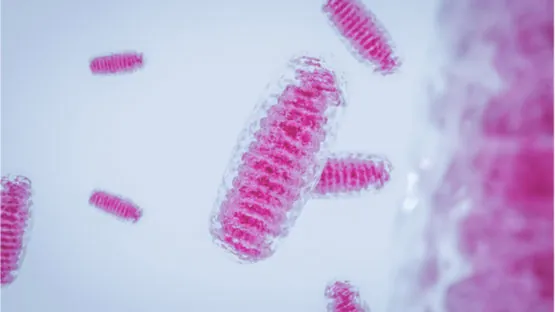Researchers from SENS Research Foundation, including Matthew O’Connor and Amutha Boominathan, have published a new study showing how codons play an important role in getting copies of mitochondrial genes placed in the cellular nucleus to express themselves correctly [1].
A possible solution to mitochondrial diseases
Mitochondrial disease is not a single disease; in fact, it is a group of rare and related conditions that are thought to affect perhaps 1 in 5000 people. These are caused due to mutations in the genes involved in the process of aerobic respiration, one of the main functions of our mitochondria.
The majority of these altered and defective genes are located in the cell nucleus within our own DNA, but there are 13 genes that are located outside the safety of the nucleus in the mitochondria themselves, and they are much more vulnerable to damage from free radicals, which are a byproduct of their own energy production.
The reason these 13 genes are outside the nucleus is a legacy of the bacterial lineage of the mitochondria; rather than being naturally part of us, they are symbiotic organelles with their own DNA, as they had descended from bacteria that infiltrated the cells of our distant ancestors hundreds of millions of years ago. These bacteria had become fully symbiotic with our cells long ago, and, slowly but surely, their mitochondrial DNA (mtDNA) has moved, one gene at a time, into our own cellular nuclei.
Mutations to the mitochondrial genes that facilitate aerobic respiration are always bad news, but mutations to the 13 genes that still reside in the mitochondria can often have severe consequences. The researchers who have published this study have been studying the mitochondria in the context of aging and disease for many years, and they have a proposed solution to the problem of mutations to these 13 genes: allotopic expression via gene therapy.
Allotopic expression is the expression of genes in the cell nucleus that are normally expressed only by the mitochondrial genome. In other words, it delivers copies of the 13 mitochondrial genes, in this case using gene therapy, into the cell nucleus and finishes the job that nature started millennia ago. The aim is for the required gene to express itself normally, thus correcting the mitochondrial disease.
So far so good, but one problem
Unfortunately, the mitochondria does not use the same genetic code that our own mammalian DNA does. Instead it utilizes its own code, which uses codon frequencies more akin to the bacteria from which it is thought to have evolved. There have been various attempts, dating back to the 1980s, to recode the mitochondrial genes so that they use the same code we do, and it was the result of these early studies that allotopic expression was first suggested. Originally used as a research tool to examine mitochondrial proteins and their interactions, this method is now being developed as a potential way to address mitochondrial disease by creating copies of genes to replace the ones mutated in the mtDNA.
This new study explores the role of codons, a sequence of three DNA or RNA nucleotides that relate to a specific amino acid or stop signal during protein synthesis. Importantly, this paper also sheds light on how optimizing codons to communicate with the mitochondria more efficiently could help allotopic expression become a workable therapy in humans.
Mutations in mitochondrial DNA can be inherited or occur de novo leading to several debilitating myopathies with no curative option and few or no effective treatments. Allotopic expression of recoded mitochondrial genes from the nucleus has potential as a gene therapy strategy for such conditions, however progress in this field has been hampered by technical challenges. Here we employed codon optimization as a tool to re-engineer the protein-coding genes of the human mitochondrial genome for robust, efficient expression from the nucleus. All 13 codon-optimized constructs exhibited substantially higher protein expression than minimally-recoded genes when expressed transiently, and steady-state mRNA levels for optimized gene constructs were 5–180 fold enriched over recoded versions in stably-selected wildtype cells. Eight of thirteen mitochondria-encoded oxidative phosphorylation (OxPhos) proteins maintained protein expression following stable selection, with mitochondrial localization of expression products. We also assessed the utility of this strategy in rescuing mitochondrial disease cell models and found the rescue capacity of allotopic expression constructs to be gene specific. Allotopic expression of codon optimized ATP8 in disease models could restore protein levels and respiratory function, however, rescue of the pathogenic phenotype for another gene, ND1 was only partially successful. These results imply that though codon-optimization alone is not sufficient for functional allotopic expression of most mitochondrial genes, it is an essential consideration in their design.
Conclusion
The MitoSENS team at SENS Research Foundation has made great strides in bringing allotopic expression via gene therapy closer to the clinic, and while there are certainly more challenges ahead to get all 13 mitochondrial genes copied to the nucleus and expressed optimally, there is plenty of room for optimism. Recently, the MitoSENS team successfully funded its second project, MitoMouse, with us at Lifespan.io, which builds on the findings in this paper to take the next step and pursue mitochondrial gene therapy in an animal model. We were delighted to have been involved in supporting this study and we wish the team the best of luck in developing allotopic expression into a workable therapy, as it has big implications for mitochondrial disease as well as aging.
Literature
[1] Lewis, C. J., Dixit, B., Batiuk, E., Hall, C. J., O’Connor, M. S., & Boominathan, A. (2020). Codon optimization is an essential parameter for the efficient allotopic expression of mtDNA genes. Redox Biology, 101429.




